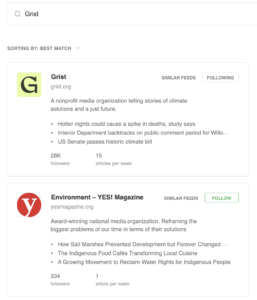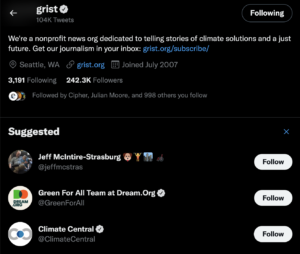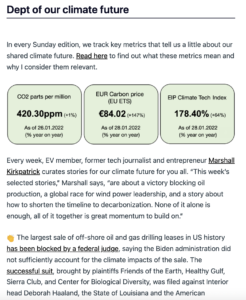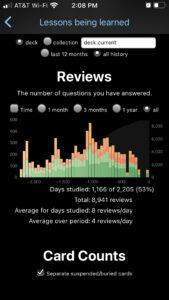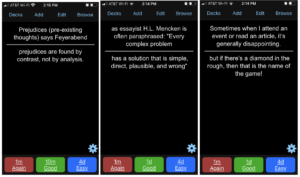
Techmeme, November, 2016
I’m excited to say that after 5+ years working at Sprinklr, the market leader for customer experience management and social media marketing for the world’s biggest organizations, I have resigned from my job and I’m soon on to my next adventure!
I thought I’d take this time to share some of the things I learned from my experience there. I hope that some of the lessons I learned and some of the experiments I succeeded with will be useful for you, my friends, to help advance the practice of continuous, life-long, social-web-enabled, professional development and to support your success in work. Let’s share and make the network smarter!
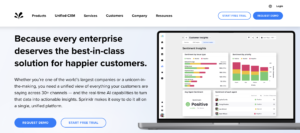 My time at Sprinklr consisted of helping the company grow from $100M in annual revenue to nearly $500M, from 1K employees to 3K, and through an IPO. That was amazing. I held VP level responsibilities for analyst relations, influencer relations, competitive intelligence, data journalism, social publishing, the customer community, live chat customer care (all at once), and some really cool custom market research projects to advise some of the biggest companies in the world. (Don’t take on too many responsibilities at once, that’s one thing I learned.) And of course I spent some time working on the influencer marketing product, but not that much. It’s been rebuilt inside of Sprinklr and I used it myself right up to my last day on the job. Thanks to the Sprinklr product team for that. (I’ll be ok without it; my therapist used to ask all the time, and I’ll be fine.)
My time at Sprinklr consisted of helping the company grow from $100M in annual revenue to nearly $500M, from 1K employees to 3K, and through an IPO. That was amazing. I held VP level responsibilities for analyst relations, influencer relations, competitive intelligence, data journalism, social publishing, the customer community, live chat customer care (all at once), and some really cool custom market research projects to advise some of the biggest companies in the world. (Don’t take on too many responsibilities at once, that’s one thing I learned.) And of course I spent some time working on the influencer marketing product, but not that much. It’s been rebuilt inside of Sprinklr and I used it myself right up to my last day on the job. Thanks to the Sprinklr product team for that. (I’ll be ok without it; my therapist used to ask all the time, and I’ll be fine.)
In a few weeks, I’ll write about what I’m doing next. I have an awesome new volunteer side-project that’s very important to me and a new job I’ll be beginning soon, which is so amazingly well-suited for my long running interests that I am beside myself with excitement about the opportunity.
But first, want to hear about my experience for the last 5+ years at Sprinklr? Quick context: You may or may not know that I started my career as a journalist, the first writer hired at TechCrunch back in 2006, then co-editor of NYT-syndicated ReadWriteWeb for much longer, then after six years as a journalist, a team and I productized my data journalism and influencer marketing practices in the form of a startup called Little Bird. We sold it to Sprinklr in 2016. I’ve met so many inspiring people online and offline along the way, thank you. I’ve been a lot more heads-down over the past 5 years than I was the prior 10+ so I appreciate you still caring enough to read this.
Here are ten things I learned while at Sprinklr that I hope you’ll find useful.
Analyst Relations
While this was my responsibility, we won 6 straight Forrester & Gartner reports as a leader or the only leader in various markets, from content marketing to sales social engagement to the entire social suite category. (If you’re unfamiliar with those firms, they do a combined $5B in annual revenue from companies subscribing to their research and advice.) AR was always a team effort, of course, with as many as 20 or more teammates working for 3 to 6 months preparing to compete in each report. (Wow!) And working with an experienced AR leader like Drew Tambling on the team was one of the biggest keys to our success.
Analysts may be less accessible to many readers here than some of the other learnings I’ll share below, but I have set up a public Google Custom Search Engine anyone can use to search across the free published work of the 7 leading tech analyst firms. Don’t start a new strategic initiative without scanning the prior art analyzed there. I use it almost daily.
Key learnings:
- Analysts have tons of great advice to share. There’s so much I want to remember that I learned from Forrester and Gartner over the last few years. A few things that stick out:
- (1) I loved Rick Parrish’s model of how to do something (anything) with discipline: he says you do it with
- Rigor (following a documented practice),
- Cadence (regularly scheduled activities),
- Co-ordination (among people and other practices),
- and Accountability (making sure there’s a senior person accountable for the work.) You put those four qualities together and you’re doing work with discipline.How delightfully well-abstracted that is. What a great model!
- (2) I loved Forrester’s advice that every change initiative can increase its odds of success if you understand that the first cohort of participants will include just a subset that are willing and able to put in the time to find success in the initiative; and then those people will be your case studies you use to market to the next cohort. Forrester says successful change management initiatives often take five years to change a company’s culture and they’ve got tons of great tools for doing that work.
- (3) And perhaps most of all, I loved Kristina LaRocca-Cerrone of Gartner’s model for democratizing data synthesis skills in organizations:
- (a) make the implicit knowledge of your most-skilled people explicit, in well-documented toolsets
- (b) tell stories of the most successful data synthesis practitioners scoring wins in their work, and
- (c) map out the network of good synthesizers and their favorite sources of data, so that anyone can tap into those sources and the network.
- (4) The biggest value the analyst firms offer is not in their market leadership reports, but in their advisory services. If your company has a subscription with one of these firms, you can schedule advisory and document reviews with them any time. The analysts are measured by how many advisory calls their customers sign up for, so they love it. And their knowledge of the industry, of best practices, of what b.s. smells like, and of customer needs is a great contribution to any strategy. The biggest, smartest companies in the world do inquiries with analyst firms all the time. When I was running AR at Sprinklr, we did more than 100 inquiry calls a year: we told everyone we could that this was an option – then we retold every happy story that resulted, to build interest in the next month’s calls. I’m really proud of that.
I will be forever grateful for the things I learned from Forrester and Gartner regarding maturity models, future-ready work skills, and so much more. What an amazing gift it was to get to lead the analyst relations team. Initially I said I didn’t want to do it; I’m glad I changed my mind.
Competitive Intelligence
Sprinklr’s competitive intelligence function, which I had the honor to be a leader in as well, was an incredible inspiration. Davin Galbraith, Elizabeth Closmore, and Asha Aravindakshan were other key leaders in that work. The breadth of their knowledge and the closeness of their collaboration with sales and product teams enabled us to win tens of millions of dollars every year in deals where competitive insights helped unseat incumbent software providers. It was awesome.
My contributions to CI varied widely, but I’ll share two fun, simple little experiments I did that worked and I recommend to anyone else willing to do the work.
- (5) Watch YouTube subscription playlists of your competitive set; they are a simple but powerful way to learn about features and market positioning relatively early. I subscribed to 10 or 15 competitors, and I booked an hour each Friday to watch any videos they’d uploaded that week. Sometimes I was the first person to watch some of them, and I was then (as was my job) one of the most knowledgable people at the company regarding what our competitors were up to. I suspect in B2B this is an underutilized avenue for market intelligence.
- (6) Internet Archive comparisons of competitive product pages offered my team and I a great view into what new tactics a competitor was trying with a product now (things they hadn’t been doing 3 months ago), or what they tried a year ago that didn’t seem to work (so they removed it from their website.) Looking at the changes over time put me in a really good position to offer strategic advice on our own initiatives based on those market signals. (“Yeah, competitor X tried an idea a lot like that 2 years ago, but it didn’t seem to work for them so they took it off their website.”) I loved being able to see things like that.
Data analysis
I managed Sprinklr’s data analysis team for some time, which helps produce amazing industry reports for partners like Twitter, LinkedIn, Forbes, and more.
Two cool things I learned about data analysis that you might find useful:
- (7) Counting things is cool, but counting their percent change period-over-period is even cooler. I loved being able to say, for example, “when people on Reddit talk about your company, these are the 10 things say about you most often. You may not be surprised by the top 3, but let me flip this chart around and sort by which of these is rising the most month-over-month. Turns out the 7th most-popular topic is rising very fast. That’s something you want to take a look at.“
- (8) Segmentation is magic. My friend Justin Garrity used to say “at Sprinklr, we can tell you not only whether fans of the TV show The Walking Dead prefer eating popcorn or ice cream while they watch the show, but even more specifically, whether the ones who like ice cream like chocolate, vanilla, or Neapolitan ice cream the best!” That’s cool, but the general principle is cooler: multi-layered boolean search queries are a non-intuitive and powerful way to learn about the dynamic constituent parts of any data set.
My favorite dashboards to build were ones that said “here are the top 10 things people talk about online when they talk about your brand, ranked first in sum total and second in percent change month over month. Then for the top 3 topics, here are the top 10 sub-topics (eg when people talk about your toy brand, they talk about “learning” a lot, and when they do, that’s made up of conversation about mentorship, school, emotional intelligence, and more, in this ranked order), and here are some samples of the most-engaged content about learning and your brand over the last 90 days.” You can pull in a ton of useful intelligence that way and I loved when I could spend an afternoon using Sprinklr to do that.
But the general principle is universally available: multi-layered boolean search queries are a non-intuitive and powerful way to learn about the dynamic constituent parts of any data set.
For example, and this is just an example of the coolness of slicing data into parts to tell a story: did you know that despite its history-making industry leadership (it’s the fastest-growing social network in history), the tech press has only written about TikTok 1.2% as much as it has the rest of the FAANG companies? And when the tech press does write about TikTok, 68% of the time they’re writing about it in the context of privacy, China, kids, or Trump. Much more often China (40% of coverage) or Trump (28%), less often privacy (23%) or children (21%). That’s just a bunch of boolean search queries with AND and OR in them, searching inside a bounded set of data (the Techmeme archives). But it’s cool. Make a few bar charts out of it and spend the ten minutes it took me to do those queries, write down those numbers, and do a little division…and you’ve got some interesting data to share. The hard part is thinking to do it in the first place.
Influencer marketing
- (9) Big companies will finally listen to and learn from influencers. I am happy to say that a decade after I got into the influencer relations game, at least some companies are now willing to relate to industry influencers as more than just a marketing channel or PR crisis protection. That’s the base level of the maturity curve, that way of looking at it. Social media influencers are market intelligence gold mines!
For example, I was really proud when one of the biggest, most famous tech companies in history turned, at the onset of COVID, to our technology to find the most credible influencers across many different topics and bring them into an internal conversation about how that company should strategize around pandemic disruption. That’s the way to do it! The people we call “influencers” are often people at the center of highly connected networks, with incredible visibility into what the market is doing and lots of lessons learned on their way to the top. Treating them like nothing more than a distribution channel is absurd, and thankfully no longer universal.
At Sprinklr, we’d do things like hire an influencer to do a three part project with us: a webinar on a well-distributed channel like AdWeek, an e-book of our shared thoughts on the topic of the webinar, and an internal advisory video call where anyone on our team could join in and privately ask this external influential thought leader their questions about the market. It was awesome! It was also a fun way to share access with junior team members to the industry leaders whose work they read and admire.
Not everyone looks at it this way, but I was proud to be named one of the world’s top 20 B2B influencer marketing pros in 2020 while flying this flag.
A great boss makes all the difference
 The tenth lesson I learned from my time at Sprinklr is that it’s amazing to work for a great boss. Sprinklr’s Chief Experience Grad Conn taught me so much, and brought so much kindness to the hard drive through an IPO.
The tenth lesson I learned from my time at Sprinklr is that it’s amazing to work for a great boss. Sprinklr’s Chief Experience Grad Conn taught me so much, and brought so much kindness to the hard drive through an IPO.
Grad prompted me to start the Sprinklr Coffee Club video podcast, which we did almost 100 episodes of, with truly amazing guests, from Rachel Happe on community to John Hagel on innovation and many more. Someday I want to just make a list of notes from the wise things the guests on that show said. There’s so much there!
I took tons of notes from things Grad said over the years, like:
- “every B2B sale is someone buying a chance of career success.”
- “People lean back when they see powerpoint, lean forward when they see white boards.”
- “You can improve the inputs of a measurement all the time, but you don’t change the outputs – you keep them consistent.”
- P&G’s three parts of a good recommendation: Why it’s strategically justified, why it’s proven, why it’s cost effective.
- Any data you show must have a recommendation to go with it.
- “Don’t trash the past, there was nothing wrong with the past, we’re just adding more stuff.”
That last one’s one of my favorites. And there was so much more.
All in all, when I look back at my time at Sprinklr, I like to use my favorite model for a debrief:
- What did you hope would happen?
- What actually happened?
- What does that gap suggest you should:
- Do differently next time?
- Keep on doing in the future?
And when I look back over the last five years at Sprinklr, I am satisfied.
Forward we go, together, internet friends. I’ll let you know what I’m up to next in a few weeks. I’m really excited about it. Let’s connect as nodes on the networks of Twitter or LinkedIn if you want to stay in communication. Thanks for your interest and support. Let’s do this internet thing together, for ourselves, each other, and where possible, for the rest of the planet.


